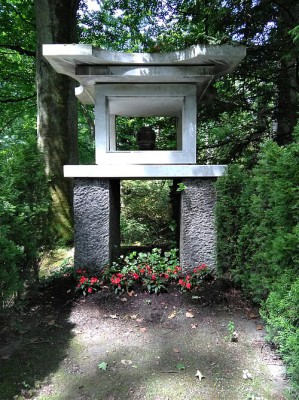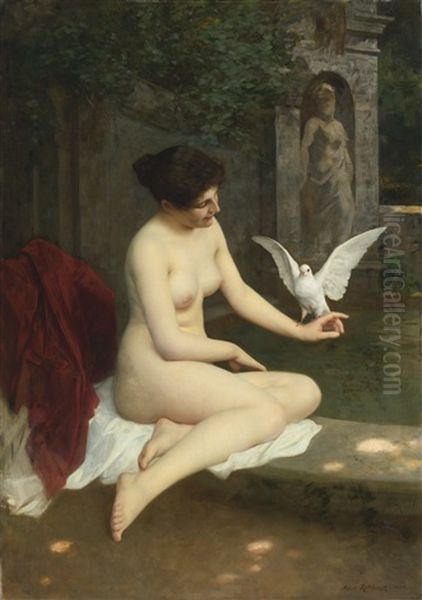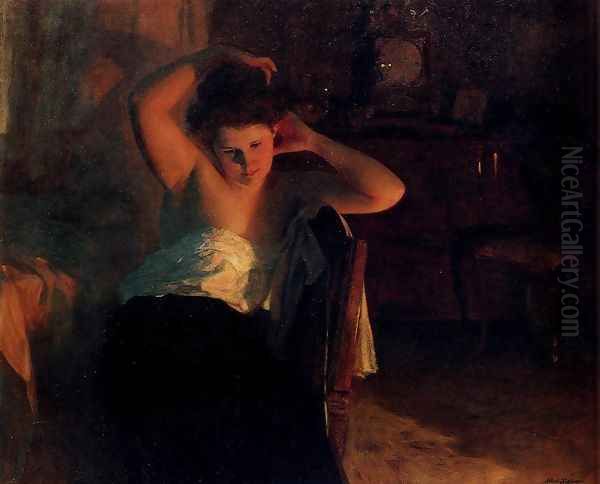
Albert Ritzberger (1853-1915) was an Austrian painter whose life and career unfolded during a period of significant artistic transition in Vienna and broader Europe. While perhaps not as globally renowned as some of his avant-garde contemporaries who spearheaded movements like the Vienna Secession, Ritzberger carved out a respectable niche for himself, primarily known for his sensitive genre scenes, portraits, and a commitment to the academic traditions in which he was trained. His work offers a valuable glimpse into the prevailing artistic tastes and social nuances of late 19th and early 20th-century Austria.
Early Life and Artistic Awakening
Born in 1853 in Austria, Albert Ritzberger emerged from a family background rooted in education, his father being a teacher. This environment likely instilled in him a sense of discipline and a respect for learning, qualities that would serve him well in his artistic pursuits. His initial foray into the art world saw him exhibiting his first painting at an art dealership in Linz, an early indication of his burgeoning talent and ambition. This early success probably provided the encouragement needed to pursue a formal artistic education.
The aspiring artist made his way to Vienna, the vibrant cultural heart of the Austro-Hungarian Empire, to hone his skills. The city's prestigious Academy of Fine Arts (Akademie der bildenden Künste Wien) was the primary institution for artistic training, steeped in classical traditions and rigorous technical instruction. It was here that Ritzberger would lay the foundations of his artistic practice.
Academic Training in Vienna
Ritzberger's formal art education in Vienna was comprehensive. During 1876 and 1877, he studied under the guidance of Ferdinand Laufberger (1829-1881). Laufberger himself was a significant figure in Viennese art, known for his historical paintings, genre scenes, and decorative works, including designs for the Vienna State Opera and the Museum of Art and Industry. He was also a respected professor at the Academy, and his tutelage would have exposed Ritzberger to the prevailing academic emphasis on precise draughtsmanship, balanced composition, and often, narrative clarity. Laufberger's own work often depicted charming, anecdotal scenes, a thematic interest that may have resonated with the young Ritzberger.

Following his studies with Laufberger, from 1878 to 1884, Ritzberger continued his training at the Academy under another influential master, Heinrich von Angeli (1840-1925). Angeli was a highly successful and internationally recognized portrait painter, favored by royalty and aristocracy across Europe, including Queen Victoria of Great Britain. His style was characterized by its elegant realism, psychological insight, and polished technique. Studying with Angeli would have provided Ritzberger with invaluable experience in portraiture, a genre that demands not only technical skill but also the ability to capture the sitter's personality and status. The emphasis on chalk portraits, which became a feature of Ritzberger's oeuvre, likely found fertile ground and development during this period under Angeli's influence.
The rigorous training at the Vienna Academy, under such distinguished figures, equipped Ritzberger with a strong technical foundation. The curriculum typically involved extensive drawing from plaster casts and live models, anatomy studies, perspective, and the study of Old Masters. This academic grounding would remain a hallmark of Ritzberger's style throughout his career.
Establishing a Career and Artistic Practice
Buoyed by his academic achievements and several awards that recognized his talent, Albert Ritzberger took a significant step in establishing his professional career in 1884 by setting up his own studio in Gumpendorf, a district of Vienna. Having a dedicated studio space was crucial for any aspiring painter, allowing for the creation of larger works and the reception of clients.
His reputation continued to grow, and he expanded his professional presence by operating studios not only in Vienna but also in Munich and Salzburg. Munich, at the time, was another major art center in the German-speaking world, with its own Royal Academy of Arts and a thriving artistic community. Operating a studio there suggests Ritzberger sought to engage with a broader artistic market and perhaps different influences. Salzburg, with its rich cultural heritage, would also have offered opportunities for commissions and inspiration.
Further testament to his standing within the Viennese art establishment was his appointment as a professor at the Academy of Fine Arts Vienna, where he taught from 1887 to 1891. This role indicates that his skills and knowledge were highly regarded, allowing him to pass on the academic traditions to a new generation of artists. It also placed him firmly within the institutional art world of the time.
Artistic Style and Thematic Focus
Albert Ritzberger's artistic style can be broadly characterized as academic realism, with a particular penchant for genre scenes and portraiture. His training ensured a high level of technical proficiency, evident in the careful rendering of figures, attention to detail in settings and costumes, and a generally polished finish.

His genre paintings often depicted intimate, everyday moments, capturing scenes from domestic life or quiet social interactions. Titles like At the Fireplace and At the Fountain suggest a focus on such unassuming yet evocative subjects. These works likely aimed to convey a sense of warmth, nostalgia, or gentle sentiment, appealing to the tastes of the bourgeois art market of the era. His ability to imbue these scenes with a subtle emotional resonance was a key aspect of his appeal.
In portraiture, particularly his chalk portraits, Ritzberger demonstrated a sensitivity to his subjects. Chalk, as a medium, allows for both delicate shading and strong lines, and he likely utilized its versatility to capture the likeness and character of his sitters. His training under Heinrich von Angeli, a master portraitist, would have been instrumental here.
While firmly rooted in academic tradition, some descriptions suggest Ritzberger's work incorporated "modern expressive techniques" and a "deep understanding of human emotion and psychology," which was "innovative for its time in Vienna." This needs to be understood within the context of late 19th-century Viennese art. The "innovation" here would likely not be the radical departures seen in Impressionism or later Expressionism, but rather a subtle infusion of greater naturalism, emotional depth, or perhaps a slightly looser brushwork compared to the stricter, more rigid forms of high academicism. Artists like Franz Defregger (1835-1921), known for his Tyrolean genre scenes, or even the earlier Ferdinand Georg Waldmüller (1793-1865), had already pushed for greater realism and emotional content within Austrian painting. Ritzberger would have been working in a Vienna that was on the cusp of major artistic upheaval with the rise of the Vienna Secession in 1897, led by artists like Gustav Klimt (1862-1918). Ritzberger, however, seems to have remained more aligned with the established academic path.
Notable Works
Several works are cited as representative of Albert Ritzberger's oeuvre:
Liebespaar (The Lovers): This title suggests a romantic or intimate scene, a common theme in genre painting. Without a specific image of Ritzberger's version, one can imagine it depicting a tender moment between a couple, perhaps in a domestic interior or a quiet outdoor setting. The execution would likely be characterized by careful attention to expression and gesture, conveying the emotional connection between the figures. The theme of "lovers" was popular across many artistic periods and styles, tackled by artists from Albrecht Altdorfer in the Renaissance to modern masters like Picasso and Magritte, each bringing their own era's sensibilities to the subject. Ritzberger's interpretation would have been filtered through the lens of late 19th-century academic sentiment.

At the Fountain: This title evokes a classic genre scene. Fountains were often social gathering points in towns and villages, or features in gardens and courtyards. Such a setting would allow for the depiction of figures in various activities – collecting water, resting, conversing. It offers opportunities for narrative detail and the portrayal of different social types. Artists like Jean-Baptiste-Camille Corot (1796-1875) or Hubert Robert (1733-1808) often featured fountains in their idyllic or picturesque landscapes, though Ritzberger's approach would likely be more focused on the human element in a realistic manner.
At the Fireplace: Similar to At the Fountain, this title points to a scene of domestic intimacy and warmth. The fireplace is often a symbol of home and comfort. A painting with this title might depict a family gathered, an individual in quiet contemplation, or a cozy social interaction. The play of light from the fire would also offer artistic challenges and opportunities for creating atmosphere. Many Dutch Golden Age painters, such as Pieter de Hooch (1629-1684), excelled at such interior scenes, and this tradition of depicting domesticity continued through the 19th century.
In Träumen Versunken (Lost in Dreams / Sunk in Dreams): This title strongly suggests a work focused on introspection and emotion. It could be a portrait or a genre scene where the central figure is depicted in a state of reverie or contemplation. Such themes were popular in Romanticism and continued to find expression in later 19th-century art, allowing artists to explore the inner life of their subjects. The ability to convey a psychological state through posture, facial expression, and overall mood would be paramount in such a piece.
These titles collectively paint a picture of an artist interested in the human condition, particularly in its quieter, more personal manifestations. His works likely provided viewers with relatable scenes and characters, rendered with the skill and polish expected from an academically trained painter.
The Viennese Art World in Ritzberger's Time
To fully appreciate Albert Ritzberger's career, it's essential to consider the artistic environment of Vienna during his lifetime. The late 19th century was a period of immense cultural flourishing but also growing tension between established traditions and emerging modern movements.
The Vienna Academy of Fine Arts, where Ritzberger studied and taught, was the dominant force, upholding classical ideals and a historicist approach. Artists like Hans Makart (1840-1884), though he died around the time Ritzberger was establishing his studio, cast a long shadow with his opulent, theatrical historical paintings. Makart's style, known as "Makartstil," influenced a generation and defined an era of Viennese painting characterized by rich colors, dramatic compositions, and often, large-scale canvases. Other prominent academic figures included the aforementioned Ferdinand Laufberger and Heinrich von Angeli, as well as portraitists like Friedrich von Amerling (1803-1887), whose elegant Biedermeier style still held sway.
Genre painting was also popular, with artists like Franz Defregger achieving great success with his scenes of Tyrolean peasant life, which combined ethnographic detail with sentimental narratives. Rudolf von Alt (1812-1905) was a master of watercolor, capturing Viennese cityscapes and landscapes with remarkable precision and atmospheric effect. These artists represented the mainstream, catering to the tastes of the imperial court, the aristocracy, and the increasingly prosperous bourgeoisie.
However, by the 1890s, a younger generation of artists began to feel constrained by the conservatism of the Academy and the official art establishment. This dissatisfaction culminated in the founding of the Vienna Secession in 1897 by a group including Gustav Klimt, Koloman Moser (1868-1918), Josef Hoffmann (1870-1956), and Carl Moll (1861-1945). The Secessionists sought to break away from academic historicism, embrace international modern art movements like Art Nouveau (Jugendstil in German-speaking countries), and create a distinctly modern Austrian art. They championed the idea of the Gesamtkunstwerk (total work of art) and held their own exhibitions, famously in the Secession Building designed by Joseph Maria Olbrich (1867-1908).
While Ritzberger was a contemporary of these revolutionary figures, his career path suggests he remained more aligned with the academic tradition. He was part of the generation that directly preceded or overlapped with the Secessionists, but his artistic inclinations and professional choices (such as his professorship at the Academy) indicate a preference for the established order rather than the avant-garde. This does not diminish his work; rather, it places him within a specific and important current of Austrian art history – that of the skilled academic painter who continued to produce quality work within recognized conventions, even as new artistic paradigms were emerging. Other artists who continued in a more traditional vein during this period included painters like Albin Egger-Lienz (1868-1926), who, while developing a powerful, monumental style, often drew on rural and historical themes, or Jehudah Epstein (1870-1945), known for his genre scenes and portraits.
Ritzberger's Legacy and Conclusion
Albert Ritzberger passed away in 1915. His death occurred during the tumultuous years of World War I, a conflict that would irrevocably change the social and political landscape of Europe, including the dissolution of the Austro-Hungarian Empire. The art world, too, was rapidly evolving, with movements like Expressionism, Cubism, and Futurism already challenging established norms across the continent.
Ritzberger's legacy is that of a competent and sensitive Austrian painter who worked primarily within the academic and genre traditions of the late 19th century. He was a product of the esteemed Vienna Academy of Fine Arts and later contributed to it as a professor. His works, such as Liebespaar, At the Fountain, At the Fireplace, and In Träumen Versunken, suggest an artist attuned to the nuances of human emotion and the quiet charm of everyday life. He provided his patrons with art that was skillful, relatable, and aesthetically pleasing according to the standards of his time.
While he may not have been a radical innovator in the vein of Klimt or Schiele (Egon Schiele, 1890-1918, representing a younger, more radical generation), Ritzberger's contribution is valuable. He represents a significant stream of artistic practice that maintained a high level of craftsmanship and catered to a consistent public demand for narrative and figurative art. His paintings offer a window into the cultural sensibilities of Vienna before the full impact of modernism transformed its artistic landscape. He stands alongside other skilled academic painters of his era, such as the German realists Wilhelm Leibl (1844-1900) or Adolph Menzel (1815-1905), whose meticulous attention to detail and human subjects found parallels in the Austrian context.
In the grand narrative of art history, which often prioritizes the avant-garde, artists like Albert Ritzberger can sometimes be overlooked. However, a comprehensive understanding of any artistic period requires acknowledging the full spectrum of its production. Ritzberger and his academic contemporaries played a vital role in the artistic ecosystem of their time, serving as educators, fulfilling commissions, and creating works that resonated with a broad public. His paintings remain a testament to a particular mode of artistic expression and a specific cultural moment in Austrian history.